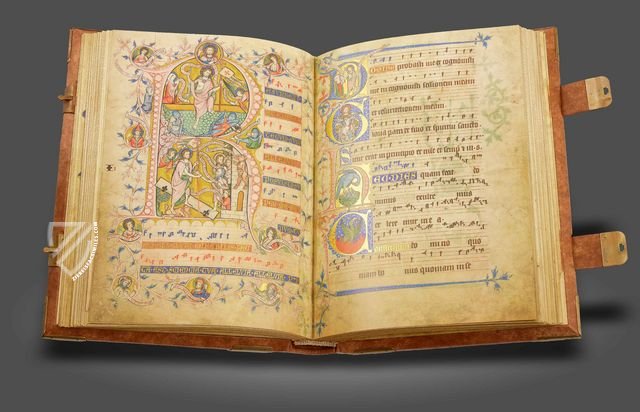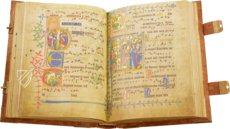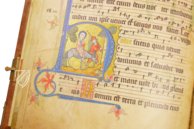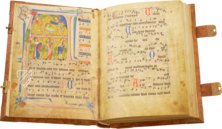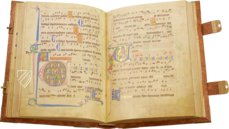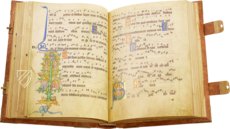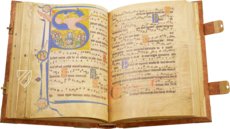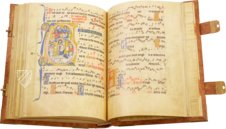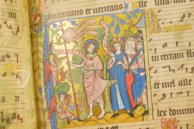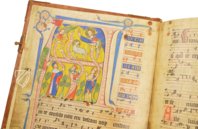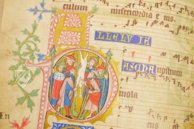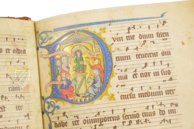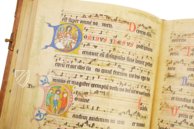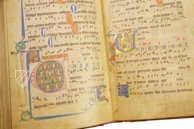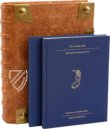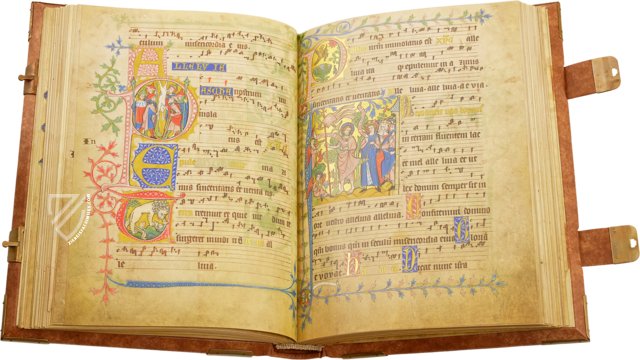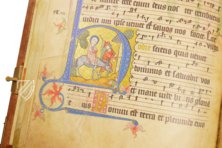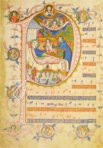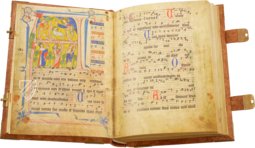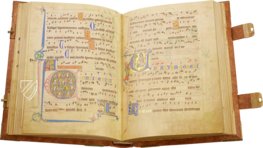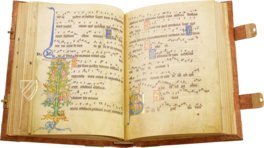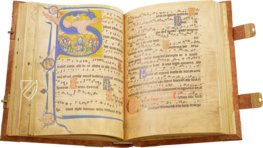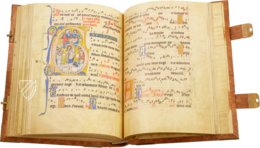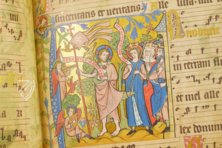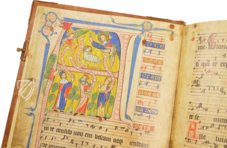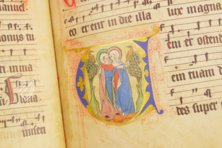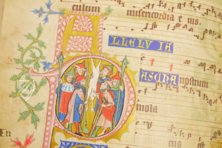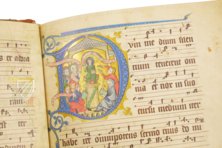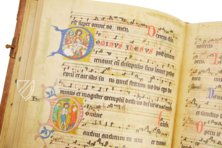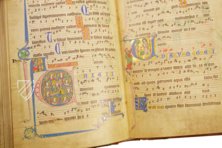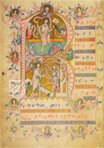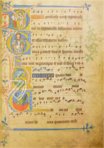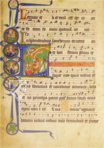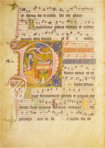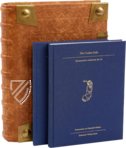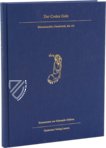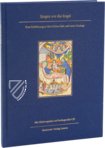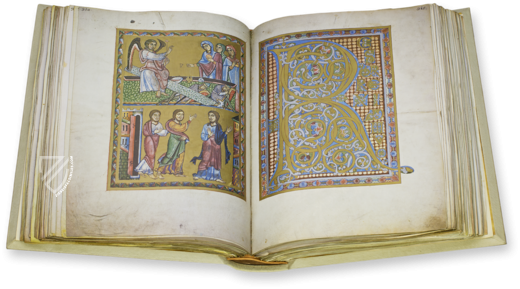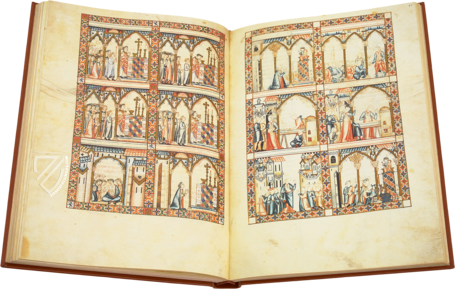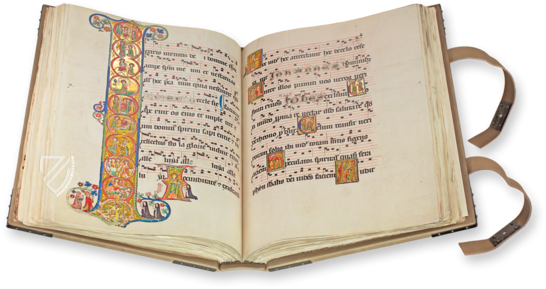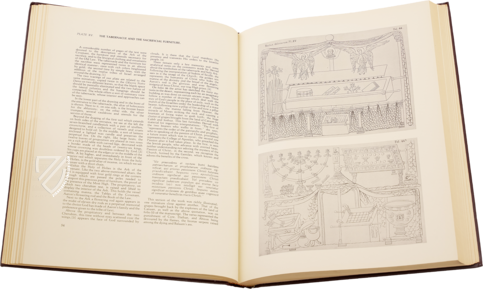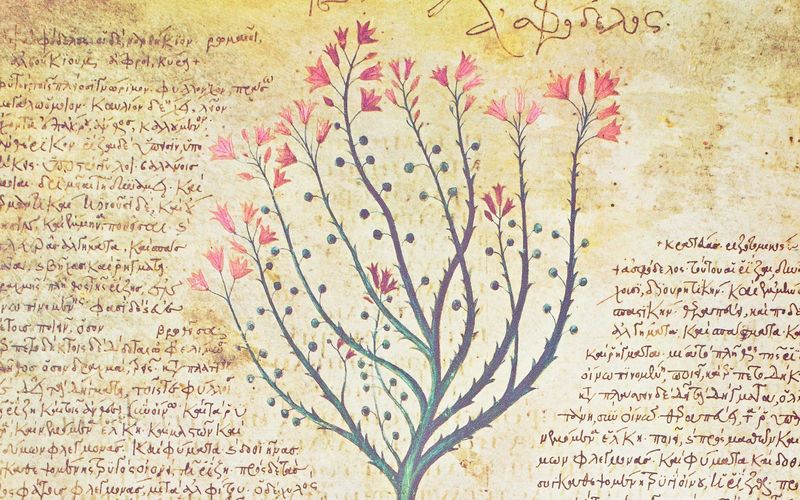Gradual of Gisela von Kerssenbrock
(7,000€ - 10,000€)
The Gradual of Gisela von Kerssenbrock is a medieval hymnal for the Gregorian choir of the Cistercian order at Marienbrunn bei Osnabrück. It was created around 1300 by the conductress Gisela von Kerssenbrock and was used at the Marienbrunn Nunnery for around 500 years. The work is renowned for its 53 magnificent historiated initials, 15 blue and gold initials entangled with flaming red tendrils, as well as 200 small, gold initials with blue and red backgrounds. Unlike most graduals, which contained around 650 hymns, the Codex Gisle has nearly 1,500 hymns in either an abbreviated or completed form. Therefore, the manuscript is not only one of the most comprehensive medieval musical codices but is also more thoroughly and elaborately decorated than any other work of its kind.
The Gradual of Gisela von Kerssenbrock
A gradual is a collection of all Latin hymns, which accompanied daily mass in monastic orders and were sung by Gregorian choirs. Such a gradual of truly exceptional quality originates from the Marienbrunn Convent in Rulle bei Osnabrück. The Gradual of Gisela von Kerssenbrock was drafted around 1300 by its namesake, Gisela of Kerssenbrock. She wrote down the notation for the Latin hymns and masterfully illustrated the pages of her work with gold initials on a polished gold background. In total the codex contains 53 embellished initials, some taking up a whole page. Additionally, there are 15 blue and gold initials entangled with flaming red tendrils, as well as 200 small gold initials with blue and red backgrounds.
The Word of God in Daily Hymns
The Gregorian choral singing was probably the most important and indispensable element of mass in medieval cloisters. The accompanied the important liturgical sacraments such as the entrance into the church, the preparation of the Eucharist, and the act of Communion. Usually a gradual from the 13th century contained around 650 hymns. The Gisela codex had a much greater volume. Nearly 1,500 hymns were contained therein in either an abbreviated or completed form.
Gisela – A Great Figure of the Abbey
Numerous depictions of nuns in their habits are recorded in the codex. One of the nuns depicted is explicitly identified as Gisela. Thereby it is verifiable that this was the Westphalian noblewoman Gisela von Kerssenbrock. She was the conductress of the choir in the Cistercian cloister of Marienbrunn. She organized the choir and the soloists, selected pieces for mass several times a day, instructed her fellow sisters in song, oversaw the library and scriptorium of the cloister, and was responsible for the production of musical manuscripts. She had one of the most important positions within the convent and applied herself to this assignment with devotion. The Codex Gisle is her most magnificent and elaborate work of art.
An Exceptional Treasure Trove of Images
As was usual in medieval graduals, the Codex Gisle limits its pictorial decoration to initials. This example is certainly decorated to so great an extent as no other work of its type. The initials were elaborated partly with whole page miniatures, which are upheld in tones of luminous blue and red and are set apart with shimmering gold backgrounds. The choirmistress Gisela impressed her deeply felt beliefs with sensible, ingenious pictures of biblical scenes. The meaning of respective hymns can be understood through the size of the text and the richness of the decoration.
A Significant History
The Codex Gisle is the artistic embodiment of the convent Marienbrunn bei Osnabrück. The gradual was in use for 500 years in one of the first 25 Westphalian nunneries of the Cistercian Order. During the period of secularization, the work came into the possession of the suffragan bishop of Osnabrück Karl Klemens, and is stored in the Diocese Archive of Osnabrück.
Codicology
- Alternative Titles
- Codex Gisle
Rulle Gradual
Graduale von Gisela von Kerssenbrock
Graduel de Gisela von Kerssenbrock - Size / Format
- 344 pages / 35.5 × 26.0 cm
- Origin
- Germany
- Date
- Ca. 1300
- Epochs
- Style
- Genre
- Language
- Illustrations
- 53 historiated initials on golden ground
- Artist / School
- Gisela von Kerssenbrock (ca. 1250–1300/01) (author, scribe, and illuminator)
German Gothic - Previous Owners
- Karl Klemens von Gruben, Bishop of Osnabrück (1769–1827)
Gradual of Gisela von Kerssenbrock
Tree of Jesse and Annunciation to the Shepherds
This fine historiated “L” initial consisting of deep blue acanthus leaves with a gold leaf background combines two popular scenes from the Nativity of Jesus. The main scene depicts the event described in the Gospel of Luke 2 when, moments after Mary gives birth, an angel of the Lord appears to shepherds tending their herd in a nearby field to bring them “good tidings of great joy”. A condensed Tree of Jesse on the left traces the genealogy of Christ to the kings of the ancient Israelites through his mother.
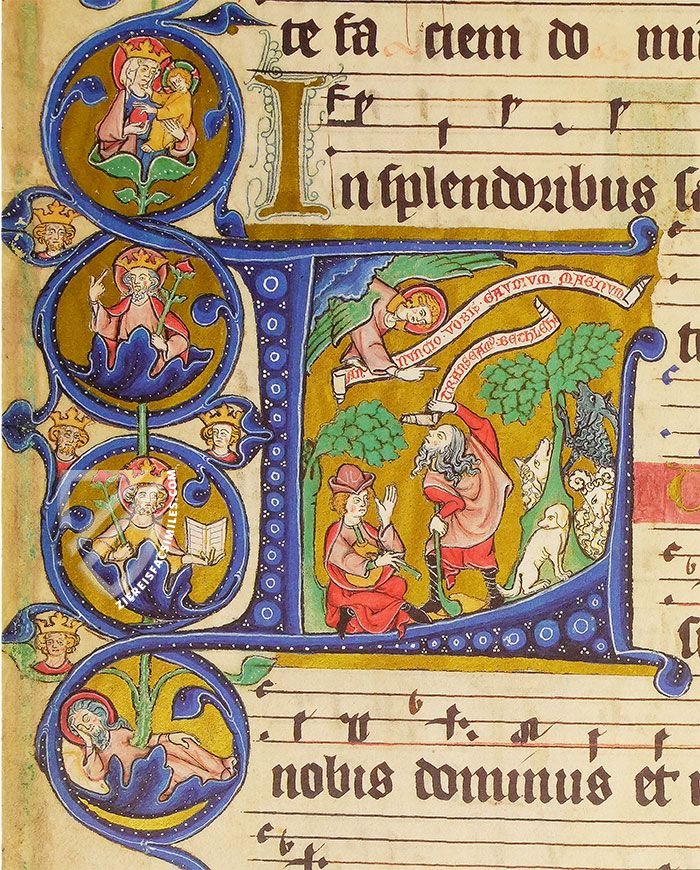
Gradual of Gisela von Kerssenbrock
Initial Page for the Introit of Easter Sunday
Easter is not only the center of the Christian faith, but also the climax of the illustrations in the Codex Gisle. This initial page for the Introit of Easter Sunday is accordingly graceful with carefully considered compositions of depth. While three Old Testament prophets in the bas-de-page form the foundation for the entire page, the seven-line R initial is framed at its four corners by the Four Evangelists in medallions. It introduces the Introit: "Ressurexi et adhuc tecum sum. - I am risen and always with you."
In its upper half, the initial shows the resurrected Christ in his special union with God the Father, who calls him to resurrection on his banner: "Ex(s)urge gl(ori)a mea! - Arise, my glory!" On the left outside the upper half of the initial stem, the nun Gisela has assigned herself a place as a devout observer of the scene, recording her name in red letters. The lower half of the R initial shows Christ's descent into limbo, where he treads victoriously on the conquered Devil and frees the souls imprisoned there. He first seizes the hand of Adam, who joyfully responds to him in his banner in Latin: "Behold the hands that created me!" (Job 10:8)
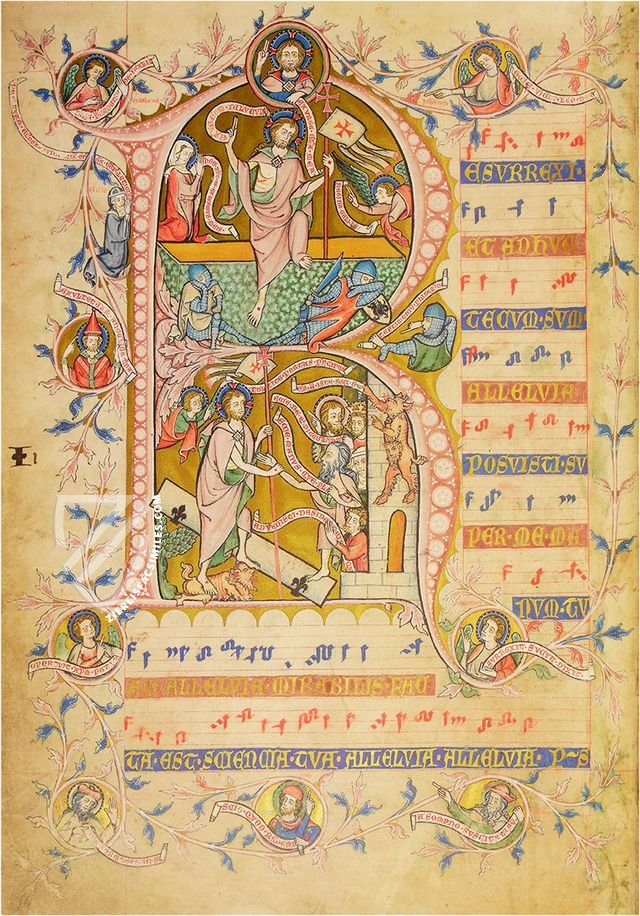
#1 Codex Gisle
Language: German
(7,000€ - 10,000€)
- Treatises / Secular Books
- Apocalypses / Beatus
- Astronomy / Astrology
- Bestiaries
- Bibles / Gospels
- Chronicles / History / Law
- Geography / Maps
- Saints' Lives
- Islam / Oriental
- Judaism / Hebrew
- Single Leaf Collections
- Leonardo da Vinci
- Literature / Poetry
- Liturgical Manuscripts
- Medicine / Botany / Alchemy
- Music
- Mythology / Prophecies
- Psalters
- Other Religious Books
- Games / Hunting
- Private Devotion Books
- Other Genres
- Afghanistan
- Armenia
- Austria
- Belgium
- Belize
- Bosnia and Herzegovina
- China
- Colombia
- Costa Rica
- Croatia
- Cyprus
- Czech Republic
- Denmark
- Egypt
- El Salvador
- Ethiopia
- France
- Germany
- Greece
- Guatemala
- Honduras
- Hungary
- India
- Iran
- Iraq
- Israel
- Italy
- Japan
- Jordan
- Kazakhstan
- Kyrgyzstan
- Lebanon
- Liechtenstein
- Luxembourg
- Mexico
- Morocco
- Netherlands
- Palestine
- Panama
- Peru
- Poland
- Portugal
- Romania
- Russia
- Serbia
- Spain
- Sri Lanka
- Sweden
- Switzerland
- Syria
- Tajikistan
- Turkey
- Turkmenistan
- Ukraine
- United Kingdom
- United States
- Uzbekistan
- Vatican City
- A. Oosthoek, van Holkema & Warendorf
- Aboca Museum
- Ajuntament de Valencia
- Akademie Verlag
- Akademische Druck- u. Verlagsanstalt (ADEVA)
- Aldo Ausilio Editore - Bottega d’Erasmo
- Alecto Historical Editions
- Alkuin Verlag
- Almqvist & Wiksell
- Amilcare Pizzi
- Andreas & Andreas Verlagsbuchhandlung
- Archa 90
- Archiv Verlag
- Archivi Edizioni
- Arnold Verlag
- ARS
- Ars Magna
- ArtCodex
- AyN Ediciones
- Azimuth Editions
- Badenia Verlag
- Bärenreiter-Verlag
- Belser Verlag
- Belser Verlag / WK Wertkontor
- Benziger Verlag
- Bernardinum Wydawnictwo
- BiblioGemma
- Biblioteca Apostolica Vaticana (Vaticanstadt, Vaticanstadt)
- Bibliotheca Palatina Faksimile Verlag
- Bibliotheca Rara
- Boydell & Brewer
- Bramante Edizioni
- Bredius Genootschap
- Brepols Publishers
- British Library
- C. Weckesser
- Caixa Catalunya
- Canesi
- CAPSA, Ars Scriptoria
- Caratzas Brothers, Publishers
- Carus Verlag
- Casamassima Libri
- Centrum Cartographie Verlag GmbH
- Chavane Verlag
- Christian Brandstätter Verlag
- Circulo Cientifico
- Club Bibliófilo Versol
- Club du Livre
- CM Editores
- Collegium Graphicum
- Collezione Apocrifa Da Vinci
- Comissão Nacional para as Comemorações dos Descobrimentos Portugueses
- Coron Verlag
- Corvina
- CTHS
- D. S. Brewer
- Damon
- De Agostini/UTET
- De Nederlandsche Boekhandel
- De Schutter
- Deuschle & Stemmle
- Deutscher Verlag für Kunstwissenschaft
- DIAMM
- Droz
- E. Schreiber Graphische Kunstanstalten
- Ediciones Boreal
- Ediciones Grial
- Ediclube
- Edições Inapa
- Edilan
- Editalia
- Edition Deuschle
- Edition Georg Popp
- Edition Leipzig
- Edition Libri Illustri
- Editiones Reales Sitios S. L.
- Éditions de l'Oiseau Lyre
- Editions Medicina Rara
- Editorial Casariego
- Editorial Mintzoa
- Editrice Antenore
- Editrice Velar
- Edizioni Edison
- Egeria, S.L.
- Eikon Editores
- Electa
- Emery Walker Limited
- Enciclopèdia Catalana
- Eos-Verlag
- Ephesus Publishing
- Ernst Battenberg
- Eugrammia Press
- Extraordinary Editions
- Fackelverlag
- Facsimila Art & Edition
- Facsimile Editions Ltd.
- Facsimilia Art & Edition Ebert KG
- Faksimile Verlag
- Feuermann Verlag
- Folger Shakespeare Library
- Franco Cosimo Panini Editore
- Friedrich Wittig Verlag
- Fundación Hullera Vasco-Leonesa
- G. Braziller
- Gabriele Mazzotta Editore
- Gebr. Mann Verlag
- Gesellschaft für graphische Industrie
- Getty Research Institute
- Giovanni Domenico de Rossi
- Giunti Editore
- Graffiti
- Grafica European Center of Fine Arts
- Guido Pressler
- Guillermo Blazquez
- Gustav Kiepenheuer
- H. N. Abrams
- Harrassowitz
- Harvard University Press
- Helikon
- Hendrickson Publishers
- Henning Oppermann
- Herder Verlag
- Hes & De Graaf Publishers
- Hoepli
- Holbein-Verlag
- Houghton Library
- Hugo Schmidt Verlag
- Idion Verlag
- Il Bulino, edizioni d'arte
- ILte
- Imago
- Insel Verlag
- Insel-Verlag Anton Kippenberger
- Instituto de Estudios Altoaragoneses
- Instituto Nacional de Antropología e Historia
- Introligatornia Budnik Jerzy
- Istituto dell'Enciclopedia Italiana - Treccani
- Istituto Ellenico di Studi Bizantini e Postbizantini
- Istituto Geografico De Agostini
- Istituto Poligrafico e Zecca dello Stato
- Italarte Art Establishments
- Jan Thorbecke Verlag
- Johnson Reprint Corporation
- Josef Stocker
- Josef Stocker-Schmid
- Jugoslavija
- Karl W. Hiersemann
- Kasper Straube
- Kaydeda Ediciones
- Kindler Verlag / Coron Verlag
- Kodansha International Ltd.
- Konrad Kölbl Verlag
- Kurt Wolff Verlag
- La Liberia dello Stato
- La Linea Editrice
- La Meta Editore
- Lambert Schneider
- Landeskreditbank Baden-Württemberg
- Leo S. Olschki
- Les Incunables
- Liber Artis
- Library of Congress
- Libreria Musicale Italiana
- Lichtdruck
- Lito Immagine Editore
- Lumen Artis
- Lund Humphries
- M. Moleiro Editor
- Maison des Sciences de l'homme et de la société de Poitiers
- Manuscriptum
- Martinus Nijhoff
- Maruzen-Yushodo Co. Ltd.
- MASA
- Massada Publishers
- McGraw-Hill
- Metropolitan Museum of Art
- Militos
- Millennium Liber
- Müller & Schindler
- Nahar - Stavit
- Nahar and Steimatzky
- National Library of Wales
- Neri Pozza
- Nova Charta
- Oceanum Verlag
- Odeon
- Orbis Mediaevalis
- Orbis Pictus
- Österreichische Staatsdruckerei
- Oxford University Press
- Pageant Books
- Parzellers Buchverlag
- Patrimonio Ediciones
- Pattloch Verlag
- PIAF
- Pieper Verlag
- Plon-Nourrit et cie
- Poligrafiche Bolis
- Presses Universitaires de Strasbourg
- Prestel Verlag
- Princeton University Press
- Prisma Verlag
- Priuli & Verlucca, editori
- Pro Sport Verlag
- Propyläen Verlag
- Pytheas Books
- Quaternio Verlag Luzern
- Reales Sitios
- Recht-Verlag
- Reichert Verlag
- Reichsdruckerei
- Reprint Verlag
- Riehn & Reusch
- Roberto Vattori Editore
- Rosenkilde and Bagger
- Roxburghe Club
- Salerno Editrice
- Saltellus Press
- Sandoz
- Sarajevo Svjetlost
- Schöck ArtPrint Kft.
- Schulsinger Brothers
- Scolar Press
- Scrinium
- Scripta Maneant
- Scriptorium
- Shazar
- Siloé, arte y bibliofilia
- SISMEL - Edizioni del Galluzzo
- Sociedad Mexicana de Antropología
- Société des Bibliophiles & Iconophiles de Belgique
- Soncin Publishing
- Sorli Ediciones
- Stainer and Bell
- Studer
- Styria Verlag
- Sumptibus Pragopress
- Szegedi Tudomànyegyetem
- Taberna Libraria
- Tarshish Books
- Taschen
- Tempus Libri
- Testimonio Compañía Editorial
- Thames and Hudson
- The Clear Vue Publishing Partnership Limited
- The Facsimile Codex
- The Folio Society
- The Marquess of Normanby
- The Richard III and Yorkist History Trust
- Tip.Le.Co
- TouchArt
- TREC Publishing House
- TRI Publishing Co.
- Trident Editore
- Tuliba Collection
- Typis Regiae Officinae Polygraphicae
- Union Verlag Berlin
- Universidad de Granada
- University of California Press
- University of Chicago Press
- Urs Graf
- Vallecchi
- Van Wijnen
- VCH, Acta Humaniora
- VDI Verlag
- VEB Deutscher Verlag für Musik
- Verlag Anton Pustet / Andreas Verlag
- Verlag Bibliophile Drucke Josef Stocker
- Verlag der Münchner Drucke
- Verlag für Regionalgeschichte
- Verlag Styria
- Vicent Garcia Editores
- W. Turnowski Ltd.
- W. Turnowsky
- Waanders Printers
- Wiener Mechitharisten-Congregation (Wien, Österreich)
- Wissenschaftliche Buchgesellschaft
- Wissenschaftliche Verlagsgesellschaft
- Wydawnictwo Dolnoslaskie
- Xuntanza Editorial
- Zakład Narodowy
- Zollikofer AG

